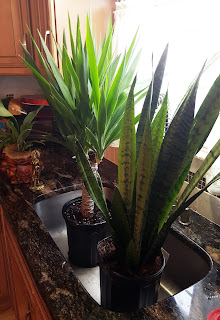Root Curry Recipe and Papaya Trees
Our big Yucca tree and the
giant snake plant in the kitchen sink, getting deep feedings and a good drink
of water.
The past week has brought some Big Snow this way. We’re buried under about 12
inches, which is an impressive amount for Southern New England.
Since
it was a stay-at-home weekend with nothing to do but shovel snow, I got into
the kitchen and invented a new vegan recipe. We have a good stock of root
veggies, and a spicy curry is always great on a cold day, so I chopped turnip,
onion, garlic, carrots, potatoes, cauliflower, and pumpkin, sautéed it in
coconut oil, then simmered it for about an hour in coconut milk, diced
tomatoes, fresh ginger, scallion, and hot Indian curry. We made a pot of red
quinoa to go with it. It was an amazing meal. It filled our tummies and warmed
us up before we went outside to move snow around.
Here’s
the recipe:
1
large turnip, peeled and chopped
12
large onion, peeled and chopped finely
6
cloves garlic, minced
6
carrots, peeled and sliced
6
white potatoes, peeled and chopped
I head
cauliflower, washed and chopped into bite-sized pieces
1
small pumpkin, washed, peeled, and chopped
½ cup
coconut oil
1 cup
coconut milk
1
large can diced tomatoes
3
stalks scallions, washed and chopped finely
1
large piece of ginger root, peeled and minced
Indian
curry spice
Red
quinoa
Saute all the raw veggies in the coconut oil for 5 minutes. Add coconut milk,
tomatoes, scallions, ginger, and curry spices, bring to a boil, lower to a
simmer, cover partly, and cook for 45 minutes to an hour. Season with sea or
Himalayan salt as needed. Serve with the cooked red quinoa.
I also
kept a pot of homemade chai going all day Sunday. I buy the ground masala spice
from a local Indian grocer. This tea was a combination of Tulsi (Holy Basil)
tea, black tea, and a lot of masala. It was super spicy and dark. Some hemp
milk softened it a little.
I also
opened a ripe papaya and ate it, then took the seeds, washed them and removed
the husks, then placed them in the fridge to stratify for three weeks. In early
March, I’ll remove them, pot them up, and place them under the growl lights to
germinate. If they decide to grow, I’ll raise a few in the house and bring a few
outside for summer.
I’ve
finally learned that fruit trees don’t like going from indoors to out or from
outdoors to in. If you’re lucky and live in a tropical climate, then the fruit
trees should be outdoors all year. If you live in New England, and want fruit
trees in your life, the best bet is to cultivate them indoors in a sunny window
and keep them there.
My
favorite hang out, Moon Dog Café in Vermont, has a storefront of
ceiling-to-floor glass, and behind the glass all year round is a variety of
fruit trees that are thriving. The micro environment that the south-facing
glass creates is warm and bright all year long.
Our
banana trees are doing well. It looks like they may survive just fine until
summer, when the cold-hardy basjoos go outside permanently, and the Thailand Black
Stems are placed in one large pot in the house where they’ll get as much sun as
possible.
Finally,
I gave the Yucca tree and the giant snake plant deep feedings and water. The
Yucca also got a pruning.
I
spent the rest of the weekend looking at photos of gardens on Instagram and
Pinterest and drooling. It was a pitiful sight. The good news: only 35 days
until spring.
Live
in peace.


